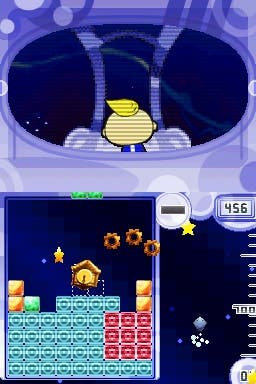Trioncube
And then decide you don't like it.
Trioncube looks a bit like Tetris, and initially it plays that way too. A rectangular play area takes up most of the touch-screen, and into this various shapes descend, each comprised of three blocks rather than the standard four (come in Alexey Pajitnov, your time is up). Unsurprisingly, your job is to rotate them using the face or shoulder buttons, position them with the d-pad, and ultimately arrange them into neat stacks with as few gaps as possible.
However, unlike Tetris, the object isn't to stack and then remove, but to keep on stacking, and stacking and stacking and stacking. By creating a square that's three blocks across, you initiate a combo, which you then have to carry on by adding blocks to the square's perimeter, or forming another square of the prescribed size elsewhere on the screen.
Helpfully, squares can overlap, so simply adding another layer of three blocks to the top of a 3x3 enables you to keep going, while adding an L-shape to a gap in the corner often does the same. You needn't worry about miscalculating, either, as little dotted outlines and brackets help you see where blocks will descend, and if they'll form combo squares when they do.
As some of you may have spotted, this means that unlike virtually every falling-blocks game ever, you're actually meant to fill the screen. Ideally, you want the chain to end when you run out of room, netting the maximum amount of points. Breaking the chain early due to bad block-positioning halts things, clears away all the blocks you'd built up to that point, reduces the amount of points and increases the pressure on you to get it right next time.

That's because your overall goal is to get a certain amount of points within a time limit. (I say points - technically we're discussing "distance" as in "distance travelled by your penguin-shaped spaceship as Penko races to save the princess from King Pluto".) Chain long enough and it's a breeze; break the chain early and often and you'll make much harder work of it.
This is true of all three single-player modes: Arcade, Story and Endless. Arcade is a string of back-to-back levels that increase in difficulty, while Story mode features some before- and after-level cut-scenes, and gold, silver and bronze target times for each of its 45 stages. There's also a shop that allows you to buy new interface graphics and sound effects with the points you earn for your chains. If you play the game for hours and hours, you can even unlock a Xevious skin.
Trioncube's hardly going to compel you to do so, mind, because it's not remotely challenging, and almost completely devoid of tension. Technically the Story mode is imposing conditions on each level to vary things - limited fuel, faster combo breakdown, and so on - but I only know this because I read it somewhere else. It's certainly not very apparent during the two hassle-free hours you spend blitzing all 45 stages twice over. Endless mode, meanwhile, gradually increases the speed of block-descent and combo-breakdown throughout its 99 "dimensions", but you'll still see all of them in an evening if there's nothing good on the telly.

It does have ways of ramping up tension. Some shapes are awkward, with individual blocks diagonal to one another in a manner that precludes easy pairing with other shapes. There's also "space junk" - dead black blocks that tumble into the play area and clog up your formations until you've set up a 3x3 block in adjacent squares, at which point they join the combo party. But even when these elements are put to use, there's still little here to match the higher levels on the original, 23-year-old Tetris, or the tougher bits of Lumines, or Meteos, or Zoo Keeper, or any number of other examples, most of which are on the DS.
The game's loath to hold you up, too, only using the above on occasion. Its other trick is to stop varying its shape selection and simply bombard you with the same shape over and over. Once you've grasped how to deal with a steady succession of each though - and it won't take you long - this proves similarly irrelevant. It's fairly soothing to sit there and pile up blocks and then watch them disappear, but it's barely if ever taxing.
That's largely because Trioncube's unique selling point - that you're trying to fill the screen rather than empty it - is also its Achilles' heel. Instead of fighting for space, you're fighting against a clock you barely ever look at, and what tension there is only manifests itself when you're pretty much down and out, which you'll sense anyway because you'll have been repeatedly frustrated by your own failure or the game's stingy offering of blocks. What's more, when that ten-second countdown appears, it's rare that you're in a position to rescue the situation.
All of which means that Trioncube is fairly dull - a sensation that the "zany" presentation usually accentuates. The Vs. mode makes up for it slightly, as you try and outpace your friend, but even then it's hardly essential, despite a single-cart download-play option. Really it's hard to think of a reason to play it or Trioncube at all. Unless you really like Xevious, obviously. Freak.

